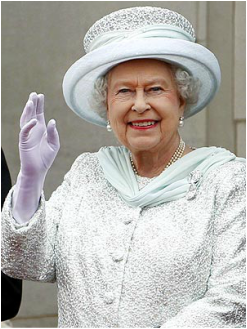 Queen Elizabeth II was born in London on April 21, 1926, although it has been British tradition to celebrate sovereigns’ birthdays on a separate official date. The Queen’s official birthday is always a Saturday in June, marked with public observances such as gun salutes and special parades, whereas her actual April birthday is celebrated in private. Her Majesty was christened Elizabeth Alexandra Mary after her mother, Queen Elizabeth, and paternal great-grandmother and grandmother, Queens Alexandra and Mary, respectively. As the eldest of two daughters – her sister, Margaret Rose, was born four years later – Princess Elizabeth was third in line for succession to the throne after her uncle, Edward, Prince of Wales, and her father, the Duke of York. The Princesses early lives were lived quietly at their family country homes. When Princess Elizabeth turned 10, however, the passing of her grandfather, King George V, and the renouncing of the throne by her uncle, King Edward VIII, led to her father’s coronation as King George VI within the year. The rapid change in royal succession suddenly thrust the young princess into the public’s eye more prominently, rendering her a subject of intense scrutiny as she now became the immediate heir to the throne by birth. Preparing for her future role as Queen, Princess Elizabeth studied constitutional history and law in addition to the typical areas of classical education for young ladies of high and noble status at the time. At 14, she made her first public speech during a live BBC broadcast, speaking to all of Britain’s children – especially those who were being evacuated during World War II. From then on, the young princess became increasingly committed to her public and civic duties, carrying out her engagements on her own or along with her parents. From her childhood governesses, the young Princess Elizabeth learned French, a skill that the now-Queen has been continuously praised for throughout her time as reigning monarch while meeting with ambassadors and heads of state in French-speaking countries. Since ascending the throne in 1952 at the age of 25, after her father’s passing, Queen Elizabeth II remains the second-longest reigning monarch, of Britain. Many of her personal and royal accomplishments have been celebrated publicly, coinciding with significant social and political developments that have occurred in tandem across the world throughout her rule. Her Majesty is known for traveling extensively, being the first British sovereign to make numerous historic, international visits to countries previously never accessed nor open to prior monarchs, from the Middle East and post-independent Republic of Ireland, to a still-divided Germany and post-war Japan. Among other “firsts,” the Queen also received the first female prime minister, Margaret Thatcher, at Buckingham Palace in 1979. Today, the Queen is 89, having outlived both her royal sister and mother. She enters her 63rd year as the beloved Queen of England, known over the world for allowing the public a more liberal glimpse into the Royal Family’s daily life while she continues fulfilling her duties. Her Majesty remains married to Prince Philip, the Duke of Edinburgh, with whom she shares four children, eight grandchildren and three great-grandchildren.
0 Comments
Your comment will be posted after it is approved.
Leave a Reply. |
Archives
July 2017
Categories
All
|
 RSS Feed
RSS Feed